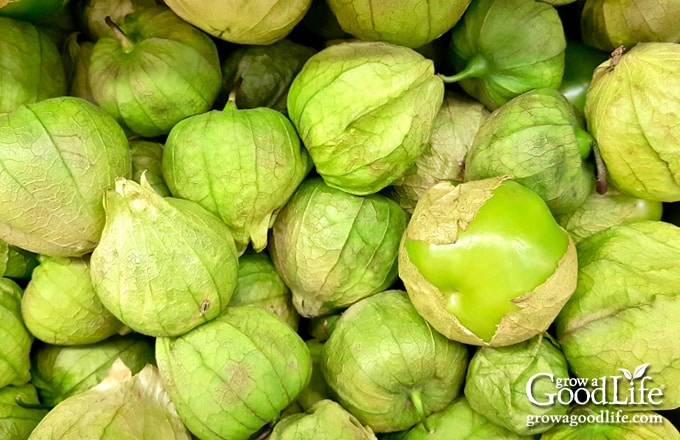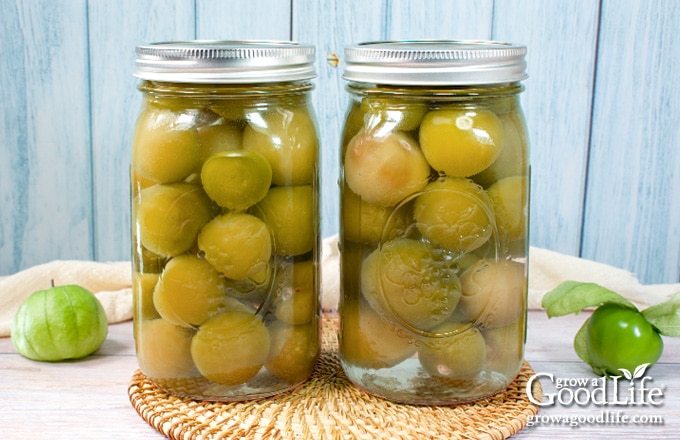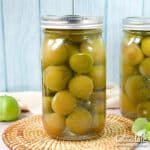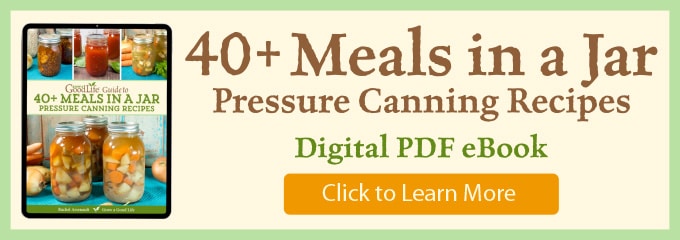Canning Tomatillos
This post may contain affiliate links, which means that I may receive a commission if you make a purchase using these links. As an Amazon Associate I earn from qualifying purchases.
Preserve the abundance from your garden by canning tomatillos using a water bath canner or pressure canner, offering an easy way to preserve whole tomatillos for year-round enjoyment.

Tomatillos, also known as husk tomatoes, are very productive plants. They can produce hundreds of fruit per plant in a season. Even in my zone 5 garden, I usually start harvesting in mid-July, and the plants continue to grow and produce more fruit until fall frost. Expect even larger yields if you garden in warmer climates.
While making and canning tomatillo salsa Verde is an excellent method for preserving a substantial harvest, consider another option: canning tomatillos on their own. This approach offers a practical solution, providing a versatile ingredient for your favorite recipes.
Canning tomatillos is so much easier than canning tomatoes. After peeling off their papery husks and washing off the sticky residue, they can be canned whole without the need to peel off the skins or remove the seeds.

Steps for Canning Tomatillos
This safe canning recipe is found in the So Easy to Preserve and USDA Complete Guide to Home Canning books and on the NCFHP website. You can preserve this recipe using either a boiling water bath canner or a pressure canner. Be sure to follow the instructions for the correct method that you are using.
Before you begin, you may find it helpful to review the canning articles on the National Center for Home Food Preservation website for Using Boiling Water Canners or Using Pressure Canners. The full and printable recipe can be found at the bottom of this article, but here are the detailed steps for canning tomatillos.
Step 1: Prepare the Canning Gear
Gather your kitchen and canning equipment and wash everything in warm, soapy water, and rinse them well. Check the jars for cracks or chips before using them, as these might break when heated. You will need:
- A water bath canner or pressure canner, depending on your chosen method.
- 4 quart-sized canning jars, or 8 pint jars if you want smaller servings.
- Canning lids and bands (use new lids for each jar, but you can reuse the bands).
- Canning tools: jar lifter, canning funnel, ladle, and bubble popper.
- Basic kitchen supplies like a large stainless steel sauce pot, a big prep bowl, measuring spoons, a large slotted spoon, and plenty of clean kitchen towels.
Step 2: Warm Up the Jars in the Canner
Place the jar rack into the canner, and position the canner on a large burner of your stove. Then, follow these guidelines to warm the jars:
For Water Bath Canning: Place the jars in the canner, and add water to cover the jars completely. Bring the canner to a simmer (180˚F) for 10 minutes, then keep the jars warm.
For Pressure Canning: Add water to the pressure canner according to the manufacturer’s guidelines: For example, Presto needs 3 quarts of water, Mirro is 2 quarts, and All American advises filling it 2 to 3 inches deep. Half-fill the clean jars with water, then stand them upright on the rack inside the canner. Bring the canner to a simmer (180˚F) for 10 minutes. Keep them warm until you are ready to fill them.
Step 3: Prepare the Tomatillos
Choose healthy firm fruit. Remove the husk and rinse the tomatillos well under clean running water to remove the sticky coating. No need to worry about peeling or seeding – these can be left whole.
Place the tomatillos in your large sauce pot, and cover them with several inches of water. Bring the pot to a boil over medium-high heat and boil gently until tender, about 5 to 10 minutes, depending on the size of your fruit. Keep hot as you fill your jars.
Step 4: Fill the Jars
Lay a clean, dry kitchen towel on the countertop, and have the citric acid or lemon juice ready alongside the measuring spoons and your canning tools.
Retrieve a warmed jar from the canner, emptying its water into the sink or tomatillo pot before placing it on the towel. Leave the remaining jars within the canner to maintain their warmth. Add the citric acid or bottled lemon juice to the jar:
- Quarts: 1/2 teaspoon citric acid or 2 tablespoons of bottled lemon juice.
- Pints: 1/4 teaspoon of citric acid or 1 tablespoon of bottled lemon juice.
Use the slotted spoon to fill the jar loosely with the hot tomatillos, then use the ladle to cover with the hot cooking liquid leaving a 1/2-inch headspace at the top of the jar.
Remove air bubbles with the bubble popper, then wipe the rim with a damp towel to remove residue. Center a lid on the jar, place the band over the lid, and screw it on until fingertip tight. Place the jar back into the canner, and repeat with the rest of the jars.
Step 5: Process the Jars
Once the filled jars are in the canner, process them according to your chosen canning method:
Water Bath Canner Method: Adjust the water level to cover the jars by two inches, bring the canner to a boil, and process the jars for the water bath canning times in the recipe below. Once the processing time is complete, turn off the heat, remove the cover, and let the jars settle for about 5 minutes.
Pressure Canner Method: Refer to your pressure canner’s instructions for sealing, venting, and heating, then process the jars for the pressure canner times indicated in the recipe below. Once the processing time is over, turn off the heat, and allow the pressure to return to zero. Unlock and remove the cover, and let the jars adjust for about 10 minutes.
Remove the jars and set them on a dry towel to cool. Keep the jars upright, and wait to test the seals. The jars need time to cool undisturbed to seal properly. Let them cool completely for 12 to 24 hours.
Test the seals after the cooling period. Refrigerate any that failed to seal and use up in a few days. Before storing your jars, remove the rings, and wash them thoroughly with soapy water to eliminate any residue. Then label, date, and find a cool spot to store the jars. For optimal flavor, consume within 12 to 18 months.

Ways to Use Canned Tomatillos
Canned tomatillos offer a versatile and convenient way to enjoy the fresh flavors of tomatillos throughout the year. They can replace fresh tomatillos in any cooked recipe. Here are some ways you can use them:
- Quick Enchilada Sauce: Make a flavorful enchilada sauce by blending canned tomatillos with roasted green chile peppers, onions, garlic, fresh cilantro, spices, salt and pepper, and a hint of lime juice. Use it as a topping or filling for tacos, burritos, and quesadillas.
- Slow Cooker Chicken Enchiladas: Make an easy chicken enchilada filling in the slow cooker by layering sliced onions, jalapeno peppers, seasoned chicken breasts, and a jar of canned tomatillos poured over the chicken. Cook until the chicken is done, then remove and shred it. Blend the sauce, add the shredded chicken to the crock, and cook for 15 more minutes. Enjoy the flavorful mixture in tacos or rolled up in tortillas for enchiladas.
- Tomatillo Salsa Verde: Create a zesty and tangy salsa by blending canned tomatillos with fresh cilantro, onions, garlic, and a hint of lime juice. This salsa can be used as a dip, sauce, or marinade.
- Puree into Dips: Blend canned tomatillos with ingredients like avocado, yogurt, or pinto beans to create flavorful dips for tortilla chips or veggies.
- Add to Soups, Stews, and Chili: Enhance the flavor of dishes by incorporating canned tomatillos. Their tangy and slightly citrusy flavor can balance out the richness of soups, stews, and chilis. I love adding a jar of tomatillos to this White Bean Chicken Chili recipe.
Canning Tomatillos
Ingredients
- 8 pounds tomatillos
- citric acid or bottled lemon juice or bottled lime juice
Instructions
Preheat the Jars and Canner:
- For Water Bath Canning: Place the jar rack into the water bath canner, place clean jars in the canner, and add water to cover. Bring the canner to a simmer (180˚F) for at least 10 minutes, and keep the jars warm until you are ready to fill them.
- For Pressure Canning: Place the jar rack into the pressure canner, and fill it with water per your canner manufacturer's instructions. Fill the clean jars halfway with hot water, and place them on the rack in the canner. Bring the canner to a simmer for 10 minutes (180˚F). Keep them warm until you are ready to fill them.
Prepare the Tomatillos:
- Remove the papery husks and rinse the tomatillos well under clean running water.
- Place them into a large sauce pan, and add enough water to cover the fruit by a few inches.
- Bring the pot to a boil over medium-high heat, and cook the tomatillos until they are just tender, about 5 to 10 minutes. Keep hot.
Fill the Jars:
- Cover your counter with a towel. Use the jar lifter to take one jar out of the canner. Pour the water into the tomatillo pot, and set the jar on the towel. Keep the rest of the jars inside the canner so they stay warm.
- Add 1/2 teaspoon citric acid or 2 tablespoons lemon juice to each quart jar. Add 1/4 teaspoon of citric acid or 1 tablespoon of bottled lemon juice to each pint-sized jar.
- Position the canning funnel on the jar. Use a slotted spoon to fill the jar loosely with tomatillos, and then top off with hot cooking liquid leaving a 1/2-inch headspace.
- Run the bubble popper through the jar to release trapped air bubbles, and adjust the headspace again if necessary.
- Wipe off any residue from the jar rim with a damp towel. Place a lid on top of the jar, position the band over it, and gently screw it on until fingertip tight.
- Place the filled jar back into the canner and repeat the process for the remaining jars.
To Process in a Water Bath Canner:
- Once the filled jars are in the canner, adjust the water level to cover the jars’ tops by at least two inches.
- Cover the canner and bring it to a boil over high heat. Once the water boils vigorously, set a timer and process pint-sized jars for 40 minutes and quart-sized jars for 45 minutes at altitudes of less than 1,000 ft. Adjust processing time for your altitude if necessary. (See notes)
- When the processing time is complete, turn off the heat, remove the cover by tilting the lid away so that steam does not burn your face, and allow the canner to cool down and settle for 5 minutes before removing the jars.
To Process in a Pressure Canner
- Once the filled jars are in the canner, place the lid on the canner and lock it. Leave the vent open and bring the canner to a boil over medium-high heat.
- Let the pressure canner vent steam for 10 minutes, and then place the pressure regulator on the air vent allowing the pressure to rise.
- When the canner has reached the correct pressure (10 pounds for weighted gauge or 11 pounds for dial gauge pressure canner), set a timer and process both pints and quarts for 10 minutes at altitudes of less than 1,000 ft.
- Adjust the pressure for your altitude if necessary (See notes), and regulate the heat as needed to maintain a steady pressure.
- When the processing time is complete, turn off the heat, and allow the canner to stand undisturbed until pressure drops to 0. Once the canner is depressurized, let the canner cool additional 10 minutes before removing the lid, and then let the jars settle for an additional 10 minutes to adjust before removing them.
Remove the Jars and Let them Cool:
- Spread a dry towel on the counter, use the jar lifter to remove the jars from the canner, and place them on the towel. Keep the jars upright, and wait to tighten bands or check the seals. Let the jars sit undisturbed for 12 to 24 hours to cool.
- After 12 to 24 hours, check to be sure the jar lids have sealed by pushing on the center. The cover should not pop up. The jar failed to seal if the top flexes up and down. Refrigerate it and use it within a few days.
- Once you have checked the seals, remove the ring bands and wash the jars in warm soapy water. Label, date, and store them in a cool, dark place. Use within 12 to 18 months for the best quality. Once the jar is open, refrigerate it and use it within a week. Yields about 4 quart jars, or 8 pints.
Notes
- Pints at altitudes of 1,001 – 3,000 ft. is 45 minutes, 3,001 – 6,000 ft. is 50 minutes, and above 6,000 feet is 55 minutes.
- Quarts at altitudes of 1,001 – 3,000 ft. is 50 minutes, 3,001 – 6,000 ft. is 55 minutes, and above 6,000 feet is 60 minutes.
- Dial Gauge Pints and Quarts at altitudes of 2,001 – 4,000 ft. increase pressure to 12 pounds, 4,001 – 6,000 ft. is 13 pounds, and 6,001 – 8,000 ft. is 14 pounds.
- Weighted Gauge Pints and Quarts at altitudes of 1,001 ft. and above, increase pressure to 15 pounds.
Nutrition
40+ Meals in a Jar Pressure Canning Recipes
In this eBook, you will find 50 pressure canning recipes, including 44 meals, along with homemade stocks and bone broths. Recipes include soups, stews, chilis, beans, beef, pork, and poultry. Explore the world of preserving delicious home-cooked meals for all seasons.


